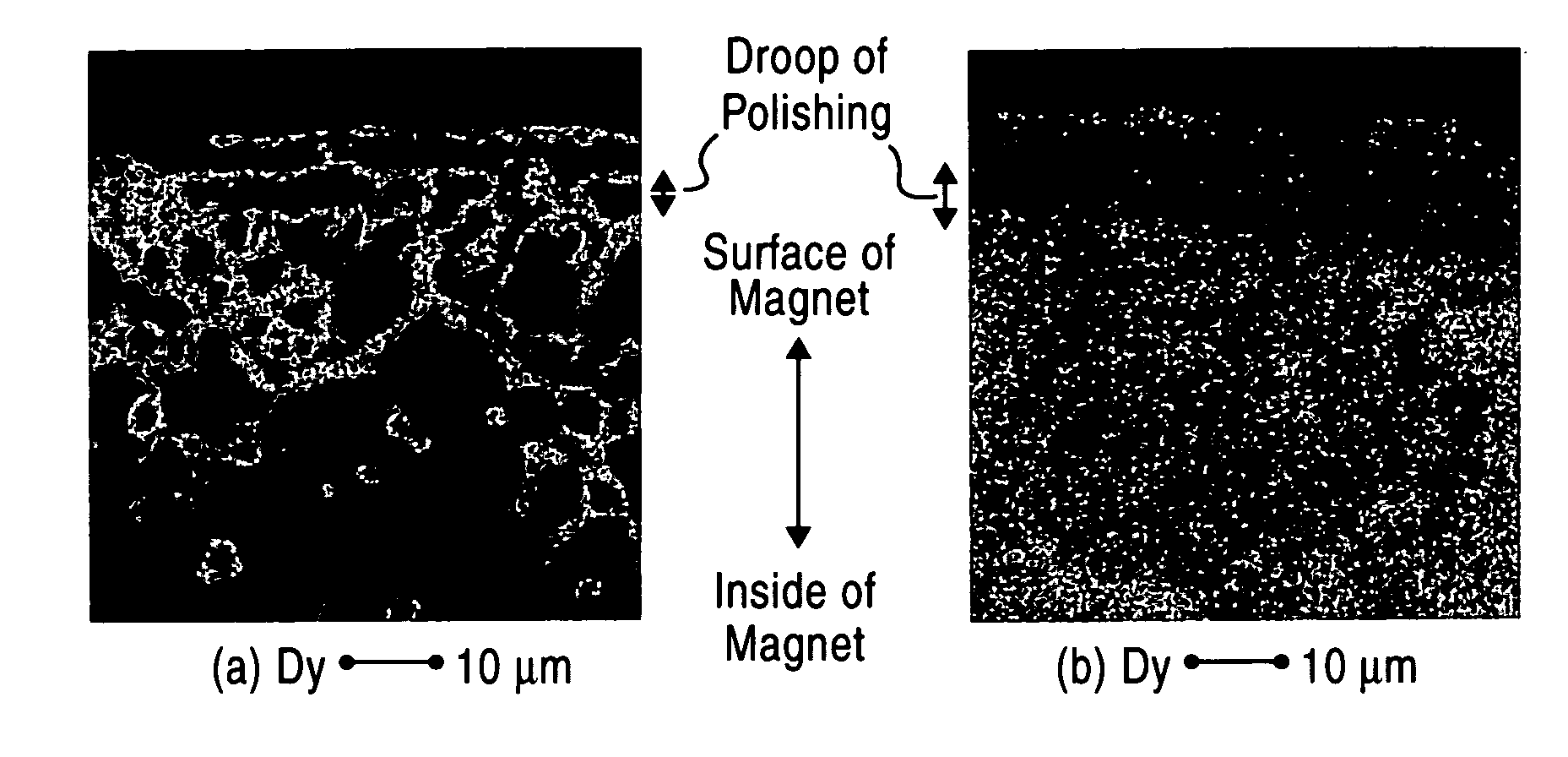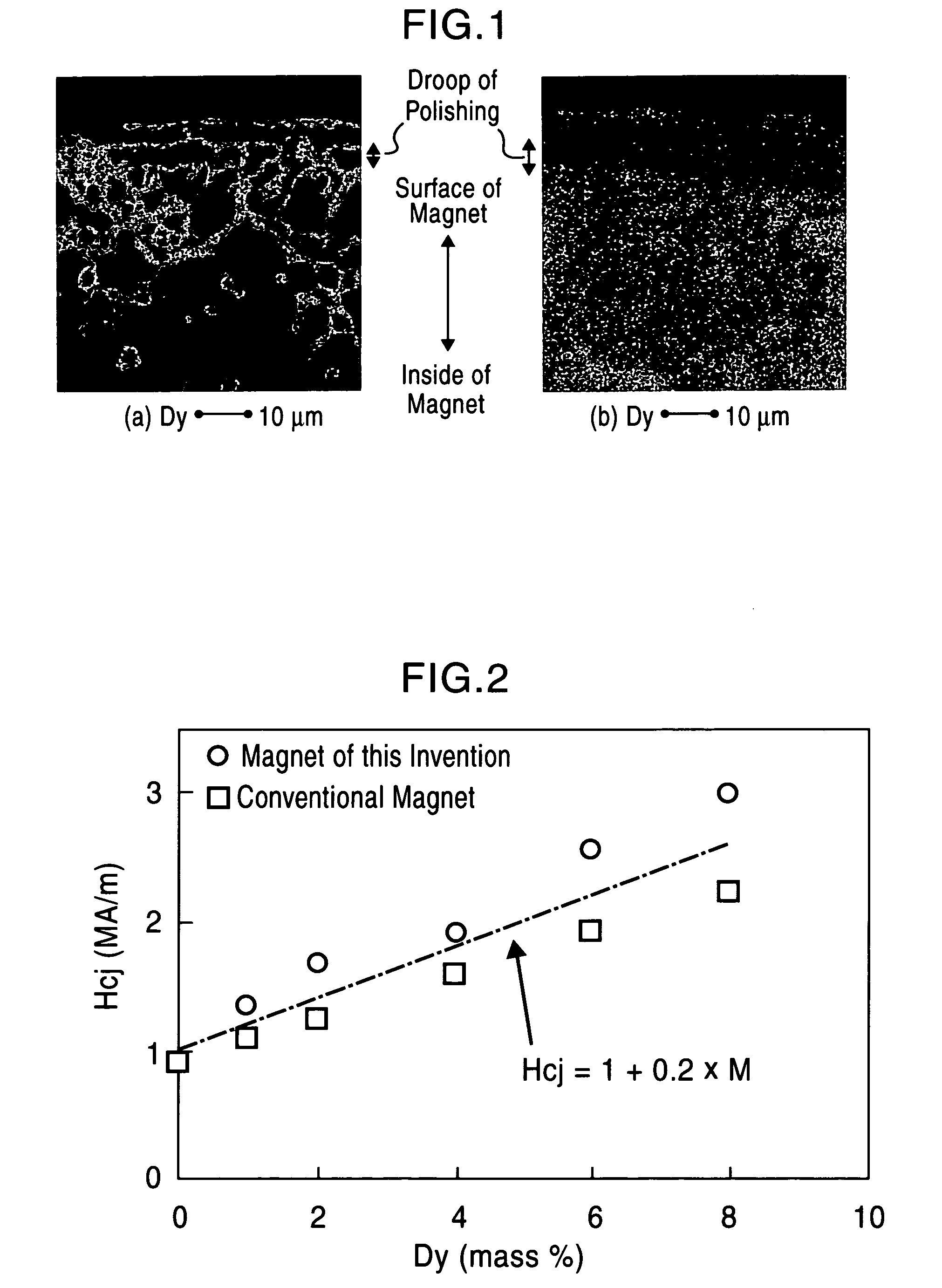Rare earth - iron - bron based magnet and method for production thereof
a technology of iron-bron and magnets, applied in the field of rare earth-iron-bron based magnets, can solve the problems of degrading the magnetic properties of the magnet surface to a few fractions of those of the inside of the magnet, and achieve the effects of improving the energy product of the magnet, high coercive force, and solving the problem
- Summary
- Abstract
- Description
- Claims
- Application Information
AI Technical Summary
Benefits of technology
Problems solved by technology
Method used
Image
Examples
example 1
[0071] An alloy thin leaf having a thickness of about 0.3 mm was formed from an alloy ingot having the composition, Nd12.5Fe78.5Co1B8, by a strip casting method. Next, this thin leaf was placed in a vessel, and hydrogen gas of 500 Pa was occluded in the thin leaf at room temperature than then released to form a powder of 0.1 to 0.2 mm in size having no regular shape. Then, the powder was ground with a jet mill to prepare a fine powder of about 3 μm.
[0072] Then, 0.05% by mass of calcium stearate was mixed with the fine powder, and the resultant mixture was charged in a mold and molded by pressing in a magnetic field. The resulting molded product was placed in a vacuum furnace and sintered at 1080° C. for 1 hour, and further machined by cutting, boring, cylindrical grinding, and the like to prepare a cylindrical magnet having an outer diameter of 2.4 mm, an inner diameter of 1 mm, a length of 3 mm, and a volume of 11.2 mm3. This magnet was used as comparative example sample (1).
[007...
example 2
[0079] A sintered magnet block having a side length of 24 mm was prepared using an alloy having the same composition Nd12.5Fe78.5Co1B8, as in Example 1 as a starting raw material, and a disk-shaped magnet having an outer diameter of 4 mm, a thickness of 1 mm, and a volume of 12.6 mm3 was formed by cutting and grinding with a grindstone and discharge processing. In a three-dimensional sputtering apparatus, a target of each of Dy and Tb metals was mounted, and the magnet was inserted in a tungsten electrode wire coil. The two targets exchanged to deposit metal films on two respective magnets. In a film deposition work, as in Example 1, oxide films of the surface of each magnet were removed by reverse sputtering, and then a RF power of 60 W and a DC power of 200 W were applied to perform normal sputtering for 5 to 50 minutes, thereby forming a film of 2 to 18 μm.
[0080] Then, one of the two magnets was placed in an electric furnace in a glove box and heat-treated at 900° C. for 10 minu...
example 3
[0085] A disk-shaped magnet having an outer diameter of 4 mm, a thickness of 0.2 mm, 0.4 mm, 1 mm, 2 mm, or 4 mm was prepared from a raw material alloy having the composition Nd12Dy0.5Fe80B7.5 by the same process as in Example 2. Next, the magnet was mounted in a three-dimensional sputtering apparatus, and oxide films of the surface of the magnet were removed by reverse sputtering. Then, a RF power of 100 W and a DC power of 120 W were applied to perform normal sputtering for 15 minutes, thereby forming a Dy metal film of 2 μm on the surface of the magnet. Next, each magnet with the film deposited thereon was placed in an electric furnace in a glove box and heat-treated at 800° C. for 30 minutes to prepare samples (16) to (20) of the present invention. Also, a sintered magnet having an outer diameter of 4 mm and a thickness of 1 mm and not subjected to sputtering was prepared as a comparative example sample (8).
[0086] The magnetic properties of each sample were measured with a vibr...
PUM
| Property | Measurement | Unit |
|---|---|---|
| heat resistance | aaaaa | aaaaa |
| crystal grain size | aaaaa | aaaaa |
| thickness | aaaaa | aaaaa |
Abstract
Description
Claims
Application Information
 Login to View More
Login to View More - R&D
- Intellectual Property
- Life Sciences
- Materials
- Tech Scout
- Unparalleled Data Quality
- Higher Quality Content
- 60% Fewer Hallucinations
Browse by: Latest US Patents, China's latest patents, Technical Efficacy Thesaurus, Application Domain, Technology Topic, Popular Technical Reports.
© 2025 PatSnap. All rights reserved.Legal|Privacy policy|Modern Slavery Act Transparency Statement|Sitemap|About US| Contact US: help@patsnap.com



